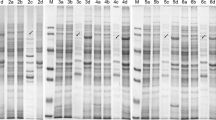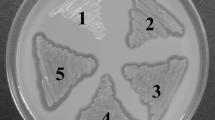Abstract
Functional expression of recombinant Pseudozyma antarctica lipase B (PalB) in Escherichia coli has been technically problematic due to protein misfolding, ineffective disulfide bond formation, and protein instability associated with intracellular proteolysis. To overcome these problems, an alternative approach was explored in this study by extracellular secretion of PalB via two Sec-independent secretion systems, i.e., the α-hemolysin (type I) and the modified flagellar (type III) secretion systems, which can export proteins of interest from the cytoplasm directly to the exterior of the cell. Both shaker flask and bioreactor cultivations were performed to characterize the developed PalB expression/secretion systems. Bioactive PalB was expressed and secreted extracellularly either as a HlyA fusion (i.e., PalB-HlyA via type I system) or an intact protein (via type III system). However, the secretion intermediates in the intracellular fraction of culture samples were non-bioactive even though they were soluble, suggesting that the extracellular secretion did mediate the development of PalB activity. Also importantly, the secretion strategy appeared to have a minimum impact on cell physiology. PalB secretion via the type I system was fast with higher specific PalB activities but poor cell growth. On the other hand, the secretion via the type III system was slow with lower specific PalB activities but effective cell growth.






Similar content being viewed by others
References
Andersen C, Koronakis E, Bokma E, Eswaran J, Humphreys D, Hughes C (2002) Transition to the open state of the TolC periplasmic tunnel entrance. Proc Natl Acad Sci USA 99:11103–11108
Anderson DM, Schneewind O (1999) Yersinia enterocolitica type III secretion: an mRNA signal that couples translation and secretion of YopQ. Mol Microbiol 31:1139–1148
Anderson EM, Larsson KM, Kirk O (1998) One biocatalyst—many applications: the use of Candida antarctica B-lipase in organic synthesis. Biocatal Biotransform 16:181–204
Better M, Bernhard SL, Lei SP, Fishwild DM, Lane JA, Carroll SF (1993) Potent anti-CD5 ricin A chain immunoconjugates from bacterially produced FabV and FabV2. Proc Nat Acad Sci USA 90:457–461
Binet R, Letoffe S, Ghigo JM, Delepelaire P, Wandersman C (1997) Protein secretion by gram-negative bacterial ABC exporters: a review. Gene 192:7–11
Blank K, Morfill J, Gumpp H, Gaub HE (2006) Functional expression of Candida antarctica lipase B in Escherichia coli. J Biotechnol 125:474–483
Blight MA, Holland IB (1994) Heterologous protein secretion and the versatile Escherichia coli haemolysis translocator. Trends Biotechnol 12:450–455
Boyer HW, Roulland-Dussoix D (1969) A complementation analysis of the restriction and modification of DNA in Escherichia coli. J Mol Biol 41:459–472
Bremer E, Silhavy TJ, Weisemann JM, Weinstock GM (1984) Lambda plac Mu: a transposable derivative of bacteriophage lambda for creating lacZ protein fusions in a single step. J Bacteriol 158:1084–1093
Choi JH, Lee SY (2004) Secretory and extracellular production of recombinant proteins using Escherichia coli. Appl Microbiol Biotechnol 64:625–635
Chung CT, Miller RH (1993) Preparation and storage of competent Escherichia coli cells. Methods Enzymol 218:621–627
Fernandez LA, de Lorenzo V (2001) Formation of disulphide bonds during secretion of proteins through the periplasmic-independent type I pathway. Mol Microbiol 40:332–346
Fernandez LA, Sola I, Enjuanes L, de Lorenzo V (2000) Specific secretion of active single-chain Fv antibodies into the supernatants of Escherichia coli cultures by use of the hemolysin system. Appl Environ Microbiol 66:5024–5029
Galan JE, Collmer A (1999) Type III secretion machines: bacterial devices for protein delivery into host cells. Science 284:1322–1328
Gentschev I, Dietrich G, Goebel W (2002) The E. coli alpha-hemolysin secretion system and its use in vaccine development. Trends Microbiol 10:39–45
Gold L (1990) Expression of heterologous proteins in Escherichia coli. Methods Enzymol 185:11–14
Gray L, Mackman N, Nicaud JM, Holland IB (2006) The carboxy-terminal region of haemolysin 2001 is required for secretion of the toxin from Escherichia coli. Mol Gen Genet 205:127–133
Grodberg J, Dunn JJ (1988) ompT encodes the Escherichia coli outer membrane protease that cleaves T7 RNA polymerase during purification. J Bacteriol 170:1245–1253
Gumpert J, Hoischen C (1998) Use of cell wall-less bacteria (L-forms) for efficient expression and secretion of heterologous gene products. Curr Opin Biotechnol 9:506–509
Hanke C, Hess J, Schumacher G, Goebel W (1992) Processing by OmpT of fusion proteins carrying the HlyA transport signal during secretion by the Escherichia coli hemolysin transport system. Mol Gen Genet 233:42–48
Hoegh I, Patkar S, Halkier T, Hansen MT (1995) Two lipases from Candida antarctica: cloning and expression in Aspergillus oryzae. Can J Bot 869–875
Hueck CJ (1998) Type III protein secretion systems in bacterial pathogens of animals and plants. Microbiol Mol Biol Rev 62:379–433
Koronakis V (2003) TolC: the bacterial exit duct for proteins and drugs. FEBS Lett 555:66–71
Krueger JK, Kulke MN, Schutt C, Stock J (1989) Protein inclusion body formation and purification. BioPharm 2:40–45
Liu D, Schmid RD, Rusnak M (2006) Functional expression of Candida antarctica lipase B in the Escherichia coli cytoplasm—a screening system for a frequently used biocatalyst. Appl Microbiol Biotechnol 72:1024–1032
Lloyd SA, Norman M, Rosqvist R, Wolf-Watz H (2001) Yersinia YopE is targeted for type III secretion by N-terminal, not mRNA, signals. Mol Microbiol 39:520–531
Majander K, Anton L, Antikainen J, Lang H, Brummer M, Korhonen TK, Wikstrom BW (2005) Extracellular secretion of polypeptides using a modified Escherichia coli flagellar secretion apparatus. Nat Biotechnol 23:475–481
Makrides SC (1996) Strategies for achieving high-level expression of genes in Escherichia coli. Microbiol Rev 60:512–538
Marino MH (1989) Expression systems for heterologous protein production. BioPharm 2:18–33
McCarter JD, Stephens D, Shoemaker K, Rosenberg S, Kirsch JF, Georgiou G (2004) Substrate specificity of the Escherichia coli outer membrane protease OmpT. J Bacteriol 186:5919–5925
Mergulhaoa FJM, Summersb DK, Monteiroa GA (2005) Recombinant protein secretion in Escherichia coli. Biotechnol Adv 23:177–202
Minamino T, Namba K (2004) Self-assembly and type III protein export of the bacterial flagellum. J Mol Microbiol Biotechnol 7:5–17
Moks T, Abrahmsen L, Holmgren E, Bilich M, Olsson A, Uhlen M (1987) Expression of human insulin-like growth factor I in bacteria: use of optimized gene fusion vectors to facilitate protein purification. Biochemistry 26:5239–5244
Olins PO, Lee SC (1993) Recent advances in heterologous gene expression in Escherichia coli. Curr Opin Biotechnol 4:520–525
Phillips TA, Vanbogelen RA, Neidhardt FC (1984) lon gene product of Escherichia coli is a heat-shock protein. J Bacteriol 159:283–287
Pollitt S, Zalkin H (1983) Role of primary structure and disulfide bond formation in b-lactamase secretion. J Bacteriol 153:27–32
Rotticci-Mulder JC, Gustavsson M, Holmquist M, Hult K, Martinelle M (2001) Expression in Pichia pastoris of Candida antarctica lipase B and lipase B fused to a cellulose-binding domain. Protein Expr Purif 21:386–392
Sambrook J, Fritsch EF, Maniatis T (1989) Molecular cloning: a laboratory manual. Cold Spring Harbor Laboratory Press, New York
Shokri A, Sande’n AM, Larsson G (2003) Cell and process design for targeting of recombinant protein into the culture medium of Escherichia coli. Appl Microbiol Biotechnol 60:654–664
Stebbins CE, Galan JE (2001) Maintenance of an unfolded polypeptide by a cognate chaperone in bacterial type III secretion. Nature 414:77–81
Szekely M (1980) From DNA to protein: the transfer of genetic information. Wiley, New York
Talmadge K, Gilbert W (1982) Cellular location affects protein stability in Escherichia coli. Proc Natl Acad Sci USA 79:1830–1833
Thanabalu T, Koronakis E, Hughes C, Koronakis V (1998) Substrate-induced assembly of a contiguous channel for protein export from E. coli: reversible bridging of an inner-membrane translocase to an outer membrane exit pore. EMBO J 17:6487–6496
Thomas NA, Finlay BB (2003) Establishing order for type III secretion apparatus-a heirarchial process. Trends Microbiol 11:398–403
Tietz NW, Repique EV (1973) Proposed standard method for measuring lipase activity in serum by a continuous sampling technique. Clin Chem 19:1268–1275
Towbin H, Staehelin T, Gordon J (1979) Electrophoretic transfer of proteins from polyacrylamide gels to nitrocellulose sheets: procedure and some applications. Proc Natl Acad Sci USA 76:4350–4354
Tzschaschel BD, Guzman CA, Timmis KN, de Lorenzo V (1996) An Escherichia coli hemolysin transport system-based vector for the export of polypeptides: export of shiga-like toxin IIeB subunit by Salmonella typhimurium aroA. Nat Biotechnol 14:765–769
van der Wal FJ, ten Hagen-Jongman CM, Oudega B, Luirink J (1995) Optimization of bacteriocin-release-protein-induced protein release by Escherichia coli: extracellular production of the periplasmic molecular chaperone FaeE. Appl Microbiol Biotechnol 44:459–465
Wan EW, Baneyx F (1998) TolAIII co-overexpression facilitates the recovery of periplasmic recombinant proteins into the growth medium of Escherichia coli. Protein Expr Purif 14:13–22
Woodcock DM, Crowther PJ, Doherty J, Jefferson S, Decruz E, Noyerweidner M, Smith SS, Michael MZ, Graham MW (1989) Quantitative evaluation of Escherichia coli host strains for tolerance to cytosine methylation in plasmid and phage recombinants. Nucl Acids Res 17:3469–3478
Xu R, Du P, Fan JJ, Zhang Q, Li TP, Gan RB (2002) High-level expression and secretion of recombinant mouse endostatin by Escherichia coli. Protein Expr Purif 24:453–459
Xu Y, Lewis D, Chou CP (2008) Effect of folding factors in rescuing unstable heterologous lipase B to enhance its overexpression in the periplasm of Escherichia coli. Appl Microbiol Biotechnol 79:1035–1044
Xu Y, Yasin A, Tang R, Scharer JM, Moo-Young M, Chou CP (2008) Heterologous expression of lipase in Escherichia coli is limited by folding and disulfide bond formation. Appl Microbiol Biotechnol 81:79–87
Xu Y, Yasin A, Wucherpfennig T, Chou CP (2008) Enhancing functional expression of heterologous lipase in the periplasm of Escherichia coli. World J Microbiol Biotechnol 12:2827–2835
Yanisch-Perron C, Vieira J, Messing J (1985) Improved M13 phage cloning vectors and host strains: nucleotide sequences of the M13mp18 and pUC19 vectors. Gene 33:103–119
Yonekura K, Yonekura SM, Namba K (2003) Complete atomic model of the bacterial flagellar filament by electron cryomicroscopy. Nature 424:643–650
Zhang N, Suen W-C, Windsor W, Xiao L, Madison V, Zaks A (2003) Improving tolerance of Candida antarctica lipase B towards irreversible thermal inactivation through directed evolution. Protein Eng 16:599–605
Acknowledgments
This study was supported in part by the Natural Sciences and Engineering Research Council (NSERC) of Canada and the Canada Research Chair (CRC) program. We greatly appreciate the E. coli strain and plasmids provided by Benita Westerlund-Wilkstrom (p5′UTR, pMCS3′UTR, and MKS12) and Luis Angel (pEHLYA2-SD).
Author information
Authors and Affiliations
Corresponding author
Rights and permissions
About this article
Cite this article
Narayanan, N., Khan, M. & Chou, C.P. Enhancing functional expression of heterologous lipase B in Escherichia coli by extracellular secretion. J Ind Microbiol Biotechnol 37, 349–361 (2010). https://doi.org/10.1007/s10295-009-0680-2
Received:
Accepted:
Published:
Issue Date:
DOI: https://doi.org/10.1007/s10295-009-0680-2




